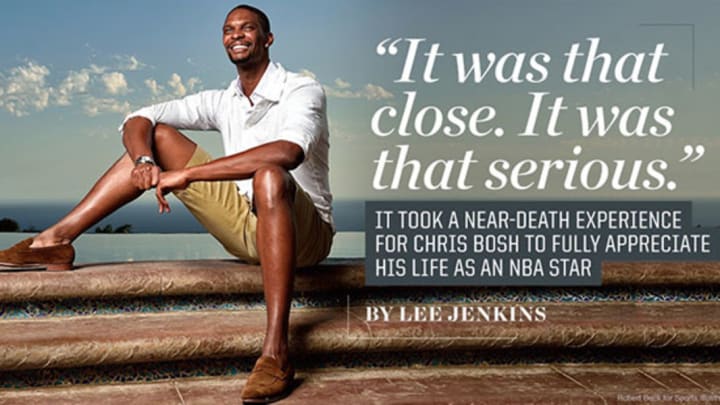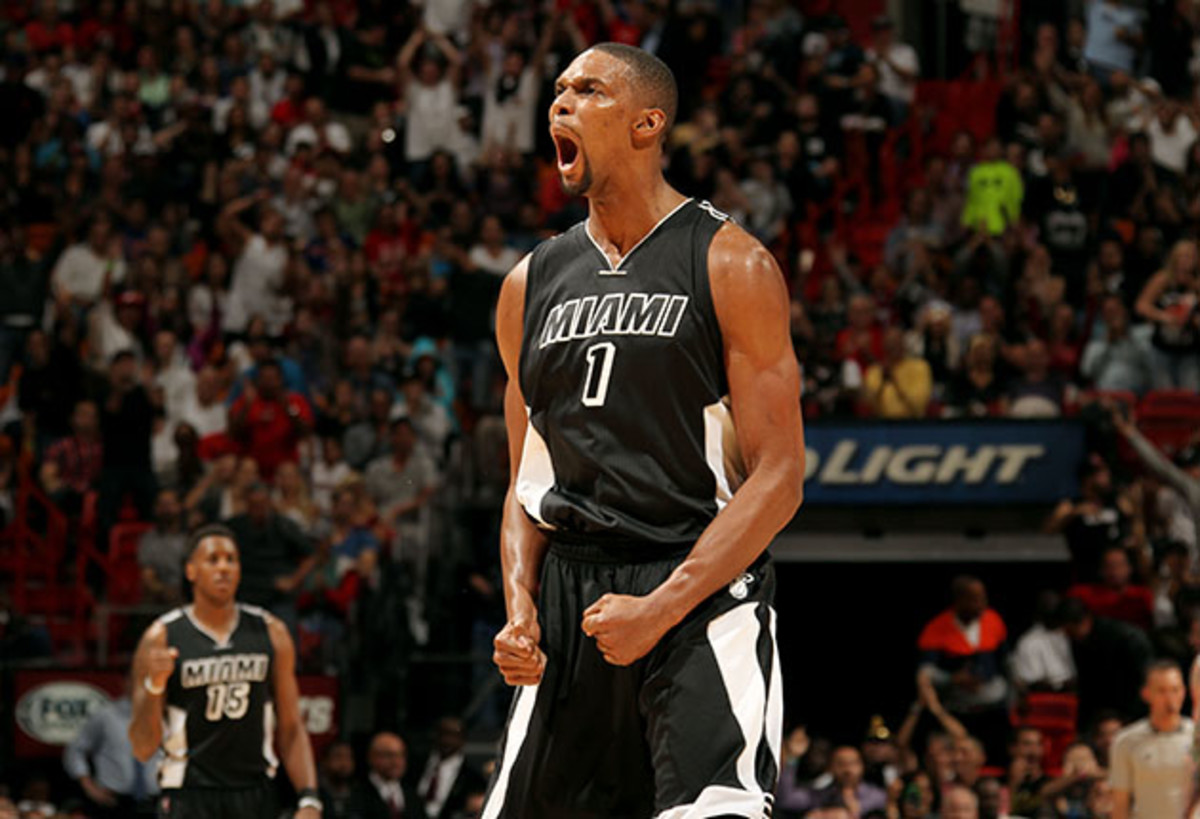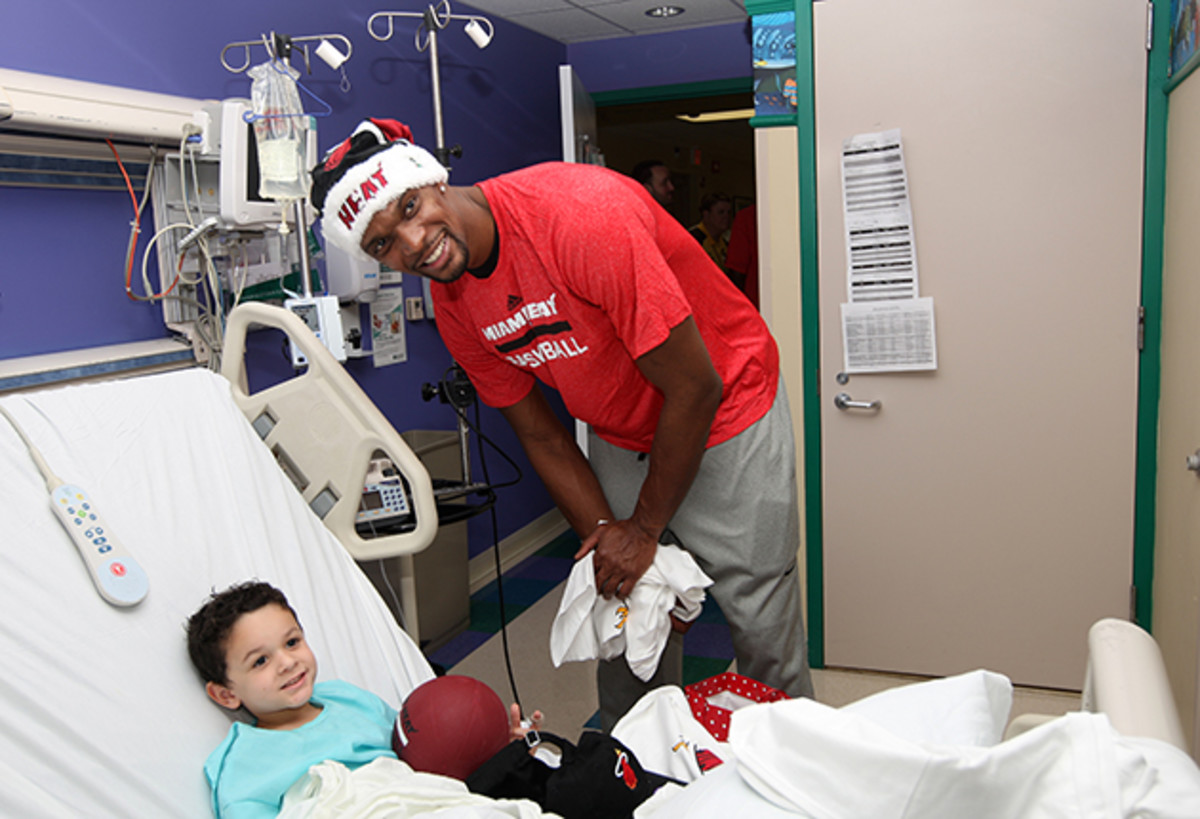Happy and Healthy: Chris Bosh values life after near-death experience

Chris Bosh spent the worst week of his life lying in a bed at Baptist Hospital in Miami, listening to the slow drip of fluid leaking from his lungs and wondering if he’d ever be able to play basketball again. “Not be able to play, not be able to live,” Bosh says. “It was that close. It was that serious.” He lifts his T-shirt to reveal matching scars on his left side, where two tubes entered his body and ran up through his chest, sucking fluid from the pleural space surrounding his lungs. “I don’t need any drugs,” he mutters, parroting his initial message to the doctors. Then he tilts his head back and howls when he recalls the tubes jabbing at his insides. “Oh, God, no, give me the drugs right now!”
Six months have passed since Bosh left the hospital, and he sits at the dining room table of his off-season home in L.A.’s Santa Monica Mountains, high above Temescal Canyon, the Pacific Ocean sparkling like a sapphire beyond the infinity pool in the backyard. A giant inflatable flamingo is the only thing obstructing the view. The property is so remote that Bosh cannot even get a cellphone signal. “That’s why I love it,” he coos. He flips open a gray notebook, filled with sketches, journal entries and to-do lists, which helps the curious big man keep track of his many interests: guitar, Spanish, acting, coding, cooking, craft beer, world travel, neckties, trail hikes and old gyms.
Kevin Durant, Kobe Bryant among 10 important comebacks of 2015–16
The book was a handout at the NBA’s technology summit, held over All-Star weekend in New York City last February. Bosh spoke at the conference and played in the game. “I was so foolish,” he says. Throughout the previous month, starting with the Heat’s road trip to L.A. in mid-January, Bosh experienced a strange sensation that most closely resembled a cramp in his left rib cage. There were times he glanced down at the skin and saw it trembling. “What the hell is this?” Bosh asked himself. A test revealed an intercostal muscle tear, so he wore a heat pack when he slept. Then he convinced himself it was a back problem, so he visited a chiropractor. But teammates Dwyane Wade and Luol Deng were also ailing, with injuries easier to diagnose, so Bosh never sat out. He scored 34 points against the Pistons while struggling to breathe, and 32 against the Knicks while grimacing during timeouts.
One night, leaving American Airlines Arena, Miami coach Erik Spoelstra spotted his 6'11" center leaning against the wall in the parking garage. “CB, are you all right?” Spoelstra asked.
“Yeah,” Bosh replied, “I’m just catching my breath from that game.”
How, Spoelstra wondered, could a rib issue affect a player’s wind? After All-Star weekend Bosh took a short vacation to Haiti, spoiled by searing chest pains. He returned to Miami and checked into Baptist, where doctors finally diagnosed blood clots on one of his lungs, which most likely originated from a left-calf contusion two months earlier. When he shared the news with his wife, Adrienne, she did a quick Internet search on his condition. The first item that popped up was an article about former Trail Blazers forward Jerome Kersey, who died the day before of a blood clot that traveled from his left calf to his lung.
For the first 36 hours in the hospital Bosh feared for his life, until doctors were able to assure him that the blood thinners they administered were working. For the next six days he feared for his career. Bosh already knew his season was over, but he still had to wait for test results that would show whether his condition was hereditary, and therefore likely to recur. “If those tests came back positive,” the 31-year-old Bosh says, “I couldn’t play anymore. For almost a week I didn’t know.”
He told himself he would be fine regardless. He had his wife, his three children and his many passions. I’ll get through it, he thought. There’s more to life than basketball. Then, as the days wore on, he became less convinced. “There’s a reason all these guys who retire go crazy. It doesn’t matter how big your house is. You have to get out of there—coding isn’t doing the trick.” He watched Heat games on his iPad and yelled at the screen as if he were stationed on the back line. “Double him! Rotate! Get a stop!” He remembered the times he had complained about role changes, ankle tweaks, extra drills. “That’s all I could think about,” Bosh says. “I felt guilty.”
• MORE NBA: Bosh 'ready to play' | Off-season grades: Southwest Division
Pain distracted him from anxiety. Bosh was diagnosed with a pulmonary embolism, the blood clots that blocked the artery in his lung. But that blockage also caused lung tissue to die, a separate condition called pulmonary infarction. “Everyone thinks I just had the blood clots,” Bosh explains. “But the clots produced a severe adverse reaction, where all this fluid built up in my lungs, and it had to come out. That was the really miserable part.” He spent four days with the tubes in his chest, another day in surgery and another day having a doctor insert a needle into the pleural space to drain excess fluid. “Doc, I really like you, but f--- this!” Bosh wailed, when he felt the needle. He was ordered to walk across his hospital room every day, and at first, he could barely sit up in bed. Then he grew more ambitious. “I can do it 10 times today!” he crowed before the agony made him reconsider. “No, that’s eight, I’m sitting down.”
Bosh is relentlessly cheerful, and he tried to act upbeat for the sake of family and friends. But when he saw a picture of himself in the hospital holding his one-year-old daughter, Dylan Skye, he nearly wept. The anguish was all over his face. “I tried to be a good sport, but sometimes I’d just lie in the bed and feel sorry for myself,” he recalls.
His father, Noel, searched for a silver lining: “You get to sit and think and reflect. When was that last time you did that?” Chris was stumped. “I don’t know if I’ve ever done that,” he replied. He tried to relax and fill his mind with everything besides the looming test results—memories of four straight NBA Finals runs, nights when Ray Allen couldn’t miss a shot or LeBron James made a pass that didn’t seem possible. “You think about so many things in that situation,” says Bosh. “Where have I been? Where do I want to go? Who am I?”
Now, six months after he walked out of the hospital, spurning the wheelchair that Heat security guards wanted him to use, he is asked if he came up with an answer to that last existential question. “Yeah,” he says, pounding a fist on the dining room table. “I’m a ballplayer, goddammit.”

Bosh has always been more than that, dating to his senior year at Lincoln High in Dallas, when he was not only a McDonald’s All-American but also a member of the National Honor Society, the Association of Minority Engineers and the Whiz Kids computer graphics club. Coach Paul Hewitt recruited him to Georgia Tech, dangling the university’s computer animation program as a carrot. He courted Bosh at the ABCD Camp in Teaneck, N.J. “You can’t talk to guys at those events, but you try to position yourself near them,” Hewitt says. “Most of them act all cool, like they don’t see you. My assistant and I posted up in a spot where we knew Chris would be. When he came by, he waved hello, and his buddies were like, 'No, no, put your hand down, act like they’re not there.' He didn’t care. He still waved.”
After one year at Tech, Bosh was picked fourth by the Raptors in 2003, and over the next seven seasons he averaged more than 22 points and eight rebounds five times. He also took Spanish classes, which he stuck with, and piano lessons, which he gave up. “Think how good I could be if I kept at it,” Bosh laments. In the epic summer of ’10, he joined James and Wade on the smoky stage in Miami after their respective decisions, and almost immediately the arrows flew. Over the next four years Bosh switched positions, sacrificed touches and redefined what the NBA expects from its giants, while absorbing as many cheap shots as anybody in sports. Kevin Durant called him a fake tough guy. Shaquille O’Neal dubbed the Heat trio the “Big Two.” Scottie Pippen went with “two-and-a-half men.”
Spoelstra describes Bosh another way: “One of the most versatile bigs who has ever played.” Bosh evolved in lockstep with the league, from a back-to-the-basket power forward who snuck some breathers on defense into a three-point shooting center who watchdogs the rim and smothers the pick-and-roll. He altered everything but his personality, remaining the compassionate colossus who once knocked on Spoelstra’s hotel room door after a brutal playoff loss, holding two beers. “Just checking on you,” he said. Bosh talks candidly, feels deeply and laughs uproariously. He reached four consecutive Finals in Miami and earned championships in 2012 and ’13, but he nearly burned out in the process. “By the end, I wanted to get off the ride,” he says, “It was going too fast. You feel almost trapped in your success. You’re like, 'Damn, I’m tired, I’m beat down, I need a break, but I want to keep winning.' That’s when you start having those thoughts: I’m more than a basketball player.”
• MORE NBA: Bosh takes on entire Late Late Show staff
He escaped into his technology books, his acting aspirations, his tie company and his summer travel to Asia and Africa. Then, in July 2014, James returned to Cleveland and the ride careened in a totally different direction. “You’re wondering, What does this mean? What’s going to happen now?” says Bosh, who still re-signed with the Heat for five years and $118 million almost immediately after James bailed. “You’re scrambling again, preparing for a new role, but you don’t know what it is yet. The stress level got super high. You want to win. You don’t want to average 22 and lose. I’ve done that already.”
Bosh scored 21.1 points per game last season, the most since his Toronto days, and the fake tough guy played a long stretch with a partially collapsed lung. The week after Bosh was released from the hospital, 35 Heat staffers showed up at his house in Miami, dropping off the 10,000 get-well cards they’d received. It took, as it sometimes does, a near catastrophe for a player to be reminded of his fans. “That’s true, but it was still nice,” Bosh says. “The multitude, for me, was intense.” He opened one card a day for two months, savoring messages much warmer than his old Twitter mentions.
SI.com's Top 100 NBA Players of 2016
On March 9, Bosh came to American Airlines Arena and asked Spoelstra if he could address the Heat before they played the Celtics. The team was six games under .500 and staggering to the finish. “I’m going to speak from the heart,” Bosh said. “I’ve sat where you guys sit, and when this game is taken away, you realize how important it is. All those things you take for granted—things like practice and shootaround—you’d do anything to get back.” He scolded himself for ever wanting off the ride, for feeling trapped in the ultimate fun house. “This is what I was born to do,” Bosh says. “I have this gift, and I’m lucky to have it. I want to do everything I can to maximize it.”
He will always be more than a basketball player. He took up the guitar five months ago, to compensate for quitting piano when he was 25, and he can strum a decent rendition of Lynyrd Skynyrd’s “Simple Man.” This summer he read Daniel Coyle’s The Little Book of Talent, hiked Temescal Ridge for a clear shot of the Pacific coast and took his annual world tour, tweeting at Wade from what he said was the back of an alpaca. He was also cleared for contact and called Hewitt seeking advice on improving his stamina. When several Heat regulars visited L.A. in August, Bosh took them to one of his favorite spots, an auxiliary gym at Malibu High. “It gets nice and stuffy in there,” Bosh says. “I like the backboard a little crooked, the nets a little stained. I don’t want air-conditioning and smooth courts. I get enough of that.”
The Heat, after a year spent recovering from shell shock, will unveil a formidable starting five when training camp opens on Sept. 29: Bosh, Wade, Deng, point guard Goran Dragic and center Hassan Whiteside. As Whiteside emerged last season, putting up 11.8 points, 10.0 rebounds and 2.6 blocks, Bosh sensed that his role would shift yet again. “That’s O.K.,” he says. “That’s fine. I don’t care if you have a role you’re not comfortable with, or you’re struggling to win games, or you think the world is against you, it’s not that bad. That’s how my mind-set has changed.” He keeps a hospital photo of himself, with the tubes, on his phone. “The next time my teammates and I don’t feel like talking on defense? Nah, man, let’s go, it ain’t that bad. Next time we lose four in a row? Hey, man, let’s get in the gym and have a good day, it ain’t that bad. It’s never that bad. My life could have been over.”

Kersey died on Feb. 18 at age 52. Darryl Dawkins died on Aug. 27 at 58. Moses Malone died on Sept. 13 at 60. The causes varied—blood clots for Kersey, a heart attack for Dawkins, heart disease for Malone—but height was a common denominator. Kersey was 6' 7", Malone 6' 10", Dawkins 6' 11". It was a scary summer to be a big man. Super-human size did not seem like such a blessing anymore. Bosh looks at the number of big men with health problems and says, “There’s a discussion we need to have about what we can do.” According to Shirin Shafazand, a pulmonologist with the University of Miami Health System, tall people are no more prone to blood clots than anybody else. But professional athletes may be, since they regularly sustain injuries and take long flights immediately afterward. “If there’s damage to the blood vessels, and then you sit on a plane for six hours without moving or staying hydrated, a clot can easily form,” Shafazand says.
Bosh does not know for sure, but he believes his clot developed on a flight from Salt Lake City to Miami last December after he was kicked in the calf during a game against the Jazz. “I didn’t wear my compression tights on the plane, which was my first mistake,” Bosh says. His second mistake was declining to see a doctor when the pain moved from his leg to his rib. “You’re trained to be tough, and you want to keep going for the team, so you kind of put your health to the side. From now on, I’m going to the doctor if I get a cold!”
He probably could not have prevented the embolism, but he might have been able to avoid the infarction, the fluid, the needle. But then he’d have missed out on the time. All that time sitting and listening and thinking about what it means to be a ballplayer, goddammit.

